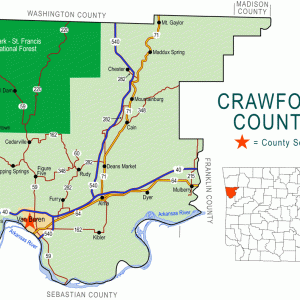calsfoundation@cals.org
Rudy (Crawford County)
| Latitude and Longitude: | 35°31’40″N 094°16’15″W |
| Elevation: | 492 feet |
| Area: | 1.59 square miles (2020 Census) |
| Population: | 130 (2020 Census) |
| Incorporation Date: | February 17, 1937 |
Historical Population as per the U.S. Census:
|
1810 |
1820 |
1830 |
1840 |
1850 |
1860 |
1870 |
1880 |
1890 |
1900 |
|
– |
– |
– |
– |
– |
– |
– |
– |
– |
– |
|
1910 |
1920 |
1930 |
1940 |
1950 |
1960 |
1970 |
1980 |
1990 |
2000 |
|
– |
– |
– |
89 |
97 |
113 |
103 |
79 |
45 |
72 |
|
2010 |
2020 | ||||||||
|
61 |
130 |
Rudy is a town in Crawford County, about five miles northwest of Van Buren (Crawford County). State Highways 282 and 348 both pass through the town.
Both before and after the Louisiana Purchase of 1803, Osage hunted and fished in northwestern Arkansas, including the region where Rudy is now located. In 1817, the present location of Rudy was included in land ceded to the Cherokee, who moved into Arkansas Territory from eastern states. A treaty signed in 1828 moved the Cherokee farther west, opening the land for white settlement. The first white settlers in what would become Rudy were families with the last names of Green and Bell, arriving in 1830 and 1835, respectively. A school building built from logs was established on the Milton Rozell property before 1840.
During the Civil War, Van Buren was captured by Federal forces in December 1862, and many freed slaves occupied farmland in the Arkansas River Valley for the duration of the war, although it is unlikely that they established homesteads as far north as Rudy. The white settlement that was slowly developing before and after the war was known as Kenton. No businesses were established in the community until the arrival of the railroad. The small community did, however, have a Masonic lodge and a chapter of the Farmers’ Alliance.
The St. Louis–San Francisco Railway (also known as the Frisco) was laid through the area in 1882. A railroad depot and post office opened the next year, both named for George Rudy, who owned the land on which the depot was built and who served as Rudy’s first postmaster. Rudy also built the first store in his namesake community, which was soon joined by a saloon owned and operated by O. W. Williams. Rudy also donated a rental house for a school and church building. Until 1890, this school operated as a subscription school. After 1890, Ruby schoolchildren were taught at Public School District 22, with the student body gathering in a white frame schoolhouse that had been built in 1878 outside of the town. A Baptist congregation was organized in 1887, and a Methodist church was built in 1891.
Rudy prospered as an agricultural center, with cotton, strawberries, peaches, and apples being shipped out of town on the railroad. Beef cattle and dairy cows were also raised on the farms surrounding Rudy. More than 100 people lived in the unincorporated community by the end of the nineteenth century. J. T. Webb built a grist mill, cotton gin, and sawmill near Rudy around 1890. Other stores were established by various citizens, including John Cooper, Sam Sloan, and Cy Carney. The Bank of Rudy opened in April 1919.
A tornado struck Rudy on September 27, 1927. The storm destroyed the school, as well as several homes and businesses and the Methodist church. The school was rebuilt and was consolidated into the Alma (Crawford County) school district in 1931. Classes continued to be held in Rudy until 1971, when the school building was destroyed by fire. A community building, used by the school as a lunch room, was built by the Works Progress Administration (WPA) in the 1930s with support from Rudy’s Home Demonstration Club. In 1934, Rudy had two general stores, both with gasoline pumps, as well as two blacksmiths and a barber shop. The town was incorporated in 1937.
An airport once operated near Rudy. A Pentecostal church was established in Rudy by 1976. Businesses in Rudy in 2010 included construction companies, plumbers, a meat-processing facility, a sod farm, a taxidermy business, and a fire district office. The population of Rudy, which at times had surpassed 100, was sixty-one in 2010; the population is mostly white, with no African Americans and four Hispanics. Near Rudy is a monument to Parley P. Pratt, a Mormon apostle who was murdered in 1857.
For additional information:
Crawford County Bicentennial Commission. An Historical Salute to Crawford County. Van Buren, AR: The Courier, 1976.
Hopkins, Eula, and Wanda M. Gray, eds. History of Crawford County, Arkansas. Van Buren, AR: Historical Preservation Association of Crawford County, Arkansas, 2001.
Steven Teske
Butler Center for Arkansas Studies
 Crawford County Map
Crawford County Map 




My great-great-grandfather George Washington Coatney lived at Rudy.